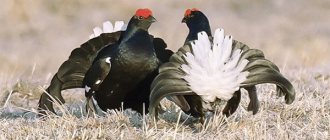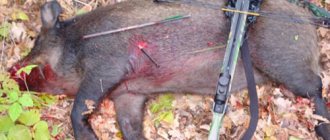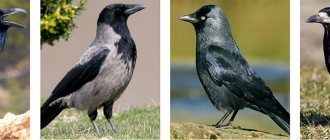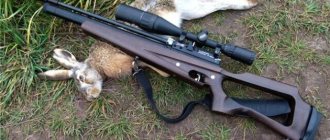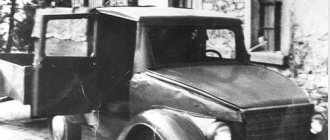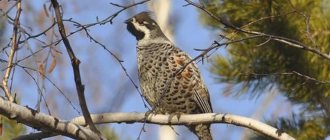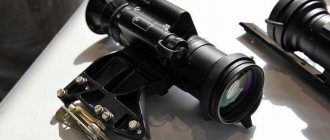Description of the hunting pheasant
Not all types of pheasants are used for breeding on farmsteads. Typically, game pheasants are bred at home. This breed was developed through long-term selection work by crossing different species of wild birds. You can see many color variations of this subspecies. Their feathers can be colored green, red, blue and snow-white.
The female has a more modest plumage than the males, but this does not prevent them from being graceful, proud and attracting many males. Birds of dark color have increased egg production and gain weight faster. Growing game pheasant of any color can be done at home.
Hunting in autumn
For the autumn period, the most optimal method of hunting is considered to be approach hunting, however, with this method, the mileage that the hunter has to walk is quite large. The presence or absence of a dog is not considered mandatory, but with the help of a four-legged friend it is much easier to pursue prey. By the way, in the fall hunting by tracking and hunting from ambush is also possible.
- Hunting from the approach is carried out as follows. The hunter slowly walks through the area and if he spooks the hare and raises it from its resting place, he must have time to make a well-aimed shot, otherwise the scythe will quickly disappear from sight. Despite the fact that this type of hunting is suitable for both hare and hare, it is still easier to see a white hare against the dark background of black soil. Hunting is especially good in the long autumn, when the hare has already moulted and the snow has not yet covered the ground.
- Tracking in the fall has its effect when hare tracks can be distinguished by the powder. Usually they focus on morning or night tracks. Earlier traces are no longer relevant. There are often enough hare tracks to follow to reach the nest. The only thing a hunter needs is sufficient experience in reading these tracks. It is also necessary that the powder or drifting soil be fresh. Prepare yourself in advance for the fact that the hare can confuse its tracks, and this is one of its characteristic features. You need to follow the trail at some distance from it. In this case, you should look around the area with a wide front. Often the hare returns on its own trail and hides in a completely unexpected place. The hunter must manage to look under his feet and forward over long distances. In calm and warm weather, the hare can let him get close to him. If it is cold or he is frightened by shots, he will get up from his prone position early enough. You need to be a sharp shooter to hit the target.
- Latch hunting brings a lot of prey at the end of autumn, especially if it happens to be a moonlit night. The most important thing in this method is choosing the right place. Otherwise, the hunter will sit in vain. If you keep quiet, you can even hear the hare approaching. The grass, slightly caught in the first frosts, produces a characteristic creaking sound. We must always remember that we are obliged to preserve nature. Of course, shooting regulates the population size, but you shouldn’t get too carried away in one area. In addition, you can ensure that the population size will provide you with hunting next year.
Residence of the hunting pheasant
In the wild, pheasants live near water, near swamps overgrown with grass, or in lowlands near sources of food - fields. The pheasant is a shy species and, in case of danger, runs away at high speed even among dense thickets.
Sometimes it flies to low altitudes, but spends most of its time on the ground. The pheasant eats weeds, grass, cereal seeds, and insects. It can often be found in the garden and pastures.
What is needed to breed pheasants?
Breeding game pheasants at home requires a high-quality and well-equipped enclosure. When constructing it, you need to take into account some features:
- The dimensions of the cage should be 2 square meters for each individual. Birds should be comfortable to move around. This is necessary so that during the period of gestation of the chicks you can freely enter the cage, find them and pick them up. Females have a tendency to forget where they just hatched them.
- The cage must be covered with a canopy.
- You need to plant trees and flowers on the territory of the aviary, make living conditions as close as possible to natural ones, and then the birds will be able to often delight you with healthy chicks.
- The place where the enclosure will stand must be dry. Remember that you need to build a bird house nearby. If you are going to raise many individuals, then it is better to build several houses.
- When raising birds in a cage, you need to take into account that they are aggressive. Therefore, it is better to keep three females with one male, but it is not recommended to keep males together.
- One of the special characteristics of game birds, which makes them easier to raise, is considered to be good resistance to low temperatures. In winter, they are not afraid of frost, so there is no need to insulate poultry houses.
About
Shotgun selection
The most common weapon for this subtype of hunting is a 12-gauge shotgun. The most significant reason for the popularity here is the large charging compartment compared to less powerful products. The second most important factor that makes the “twelve” especially popular is versatility.
Many people prefer to hunt pheasant with a 20 or 30 gauge shotgun. In the first case, a good option would be Browning Superlate Lightning or Winchester 101. If we talk about the more universal “thirty,” Feser XS, as well as Winchester Super-X, can provide excellent results. Among those that have proven themselves in terms of hunting birds, it is also advisable to highlight: Mosberg 500, Weserby SAS, Beretta AD391, Browning BPS, Winchester 12.
In terms of the design features of a shotgun for bird hunting, not only the caliber is important. One of the important points is the number of trunks and their location. For example, a double-barreled shotgun with horizontal barrels can be considered a classic version of pheasant hunting. The advantages of the product in this case include light weight, ergonomics, and fewer moving elements, which significantly reduces the likelihood of breakdown. But such a gun also has certain disadvantages: quite noticeable recoil when fired, as well as a relatively high price.
There are many admirers of shotguns with a movable forend. But there are a couple of drawbacks to note here. These include noticeable recoil and quite a lot of noise produced by the shutter mechanism of the product.
Bird hunting professionals recommend using a whole range of guns of other models. These are the semi-automatic Browning Auto 5 and Remington 1100/1187/Sportsman 58, the classic Remington 870, Beretta 391 shotguns and Browning Sitori 20 gauge. Those who prefer “verticals” (a pair of barrels located one below the other) should pay attention to Valmet 412, Verona 502 LX 20g, Benelli Monte, Beretta Silver Pigeon.
Separately, it is advisable to note such a parameter as the weight of the gun. When hunting, you have to constantly carry a weapon with you, so a heavy product may be the wrong choice, but a light gun is ideal. In addition, there is always the opportunity to purchase shotguns for hunting birds by placing an order in advance.
Feeding of hunting pheasants
Pheasants are extremely selective in food and are voracious. They need a lot of high-quality and balanced food. It is usually based on wheat, corn, barley, and oats. You can also give feed, bran, cake.
Pheasants love raw vegetables and fruits. Before creating food, it is better to finely chop carrots, potatoes, cabbage, and pumpkin. To support the immune system, add bone meal and fish oil to your food. Pheasants need fresh greens. If there is no vegetation at the place where they are grown, be sure to plant grass. Pheasants love bugs and insects.
The game pheasant is the only bird that eats the Colorado potato beetle. Farmers note that in those places where pheasants live there are no problems with the Colorado potato beetle. Therefore, if you have a potato field, you can safely buy a pheasant and breed it. One bird requires 75 grams of feed during normal conditions and 80 grams at the time of breeding.
Keeping pheasants at home
The suitable age for producing offspring of males at home is from 1 to 2.5 years, females - from 8 months to 2 years. Two weeks after mating, females begin to lay eggs. At this time, they create nests, lay down in them and begin to wait. At such times, the female needs to be fed frequently, since she does not eat anything and strives to bear healthy babies.
Another difficulty is that the female forgets where she last laid eggs. They need to be collected when the female is feeding. The easiest way to breed chicks is at home, placing eggs under a hen or in an incubator. Selecting and storing eggs in an incubator is a necessary condition, as is the case with other birds.
Since the female does not lay eggs at the same time, the chicks are born with an age difference of several days. Pheasant eggs are easy to care for if you follow simple rules and do not neglect them. They are born wet and weak. First you need to pick them up, dry them and put them back in place.
About
Shooting with pneumatics
As a rule, pneumatics are used by people who like to hunt birds. It should also be noted that different calibers are used for different game. Thus, shooting from the air is suitable for pheasants, or you can use pneumatic guns with 4.5 mm caliber cartridges.
The caliber is 4.5 mm, just right for shooting birds. A 4.5 mm bullet kills the bird immediately. It should also be noted that when going hunting, you will need to disguise yourself so as not to scare away the bird. When shooting, you must try to hit the head or chest. It is better to shoot pneumatics with 4.5 mm bullets at a distance of 30 meters.
Caliber 4.5 mm
It is recommended to make sure that there are no people along the flight path of a 4.5 mm bullet before firing. Because 4.5mm can hurt a person.
If you undergo certain training, you can use pneumatics to hunt other animals, for example, foxes or large animals. Of course, 4.5 mm will not be enough for such shooting. You can get pneumatic guns of different types and capacities, which are designed for shooting different animals.
Rules for raising chicks
The main condition for breeding hunting pheasant chicks at home is considered to be optimal temperature. In the first few days the temperature should be +28 degrees. Then it can be gradually reduced. The main thing is that the temperature should not be below +20 degrees. At first, it is better to give boiled eggs with finely chopped herbs as food.
Keeping chicks in a cage makes caring for them much easier, which allows you to create more comfortable conditions for them. It is necessary to strictly control the growth and development of pheasants. Thus, when keeping chicks on the floor, you need to install a sectional room with bedding. The lower part is intact with a height of up to 0.5 meters - so that there are no drafts.
The building density is 20-25 chicks per square meter. During the first three weeks it is necessary to heat the premises. The suitable temperature is +33 degrees. To find out how much the chick has grown, look at the feather pattern. In two-week-old hunting chicks, the closed wings completely cover the body, the length of the flight feathers is 2-3 mm.
In chicks at the age of 1 month, the feathers are fully formed, they can be distinguished by gender. At the age of 2 months, juvenile molt appears in chicks. Sometimes you can see the stubs of a real feather. As time passes, the juvenile plumage changes.
If you decide to breed hunting pheasants, you must first become familiar with the peculiarities of their breeding. But, as experienced breeders note, this is one of the easiest to care for and maintain among the entire pheasant family.
About
Rules defined by law
The law defines the rules of hunting, partly for the safety of the hunters themselves. There are many known accidents when, during a collective hunt, members of a group managed to injure each other. A clear algorithm of actions is prescribed for a raid hunt, since it in itself is a rather complex undertaking.
First, each group member must familiarize himself with the safety rules and endorse this fact with his signature in a special journal.
The leader of the group, who is also the manager, places all participants in their places, which are assigned numbers for convenience. It is prohibited to leave your room during the hunt. If this is necessary, the manager should be informed. Often guards are assigned and placed at the edges of the shooting line. Their task is to prevent other animals or random oncoming people from entering the field of fire. The beaters wear bright vests and must lift the hare and make it run towards the shooters.
Control may be encountered during the hunt. It is within his competence to request permits for inspection. The hunter must present a permit (permission to shoot hares issued by the hunting department), a hunting license, and a license to carry a weapon. Naturally, the listed documents should always be with you. Alcohol is taboo. Being intoxicated while hunting is even punishable by law (although the punishment itself is qualified as carrying a weapon while intoxicated, and hunting is not the determining factor here).
Each hunter can load or unload a gun only on his own number and only after receiving permission from the manager. If semi-automatic shotguns are used for hunting, they should only be loaded with two rounds. In some cases, the law allows five rounds. And the magazine capacity of many semi-automatic machines is five. However, when hunting a hare, you should only load two cartridges.
The law does not establish which shot numbers to use in hare hunting, but bullets definitely cannot be used. It is prohibited to fire a shot if the target is not clearly visible. When using hounds, shooting from under dogs begins only with the knowledge of their owner, although such a rule is not reflected in the law. A hare killed by other people's dogs is usually given to the dog's owner in exchange for two cartridges. If one hunter wounded a hare and the second finished it off, then the trophy goes to the first hunter in exchange for two cartridges. It is not customary to beat a hare while lying down; it is first raised. The latter rules are called hunting ethics.
